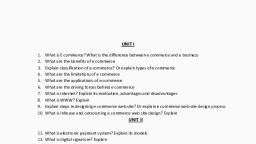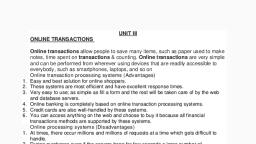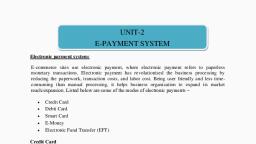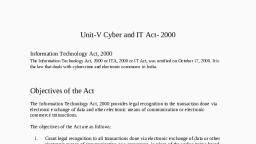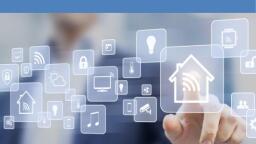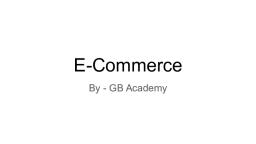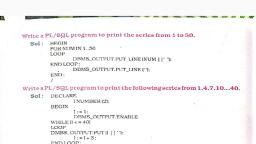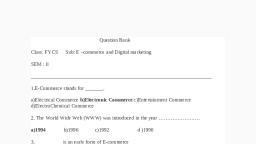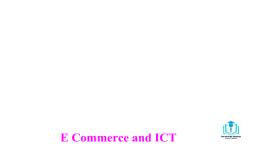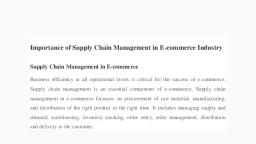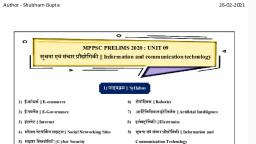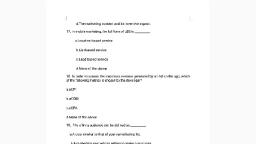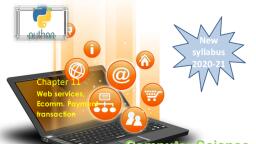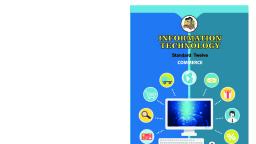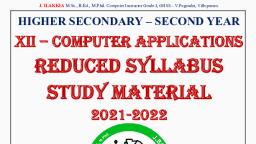Page 1 :
E COMMERCE AND WEB DESIGNING, UNIT-1, Meaning of business:A business (also known as an enterprise or firm ) is an organization engaged in the trade, of goods , services , or both to consumers ., Meaning of business:A general term that refers to any type of business activity on the internet, including, marketing, branding, and research., Branding: - The process involved in creating a unique name and image for a product in the, consumer’s mind, mainly through advertising campaigns with a consistent theme., Commerce: - The buying and selling of products and services between firms, usually in different, status or countries., E-commerce: - e-commerce means buying and selling of products or services over electronic, systems such as the internet and other computer networks., Difference between E-business and E-commerce:In both cases , E stands for “Electronic networks “ and describes the applications of, Electronic network technology – including internet and electronic data interchange (EDI) – to, improve and change business process ., E-commerce covers outward - facing processes that touch customers , suppliers and, external partners , including sales , marketing , order taking , delivery , customer service , purchasing, of raw materials ---., E-business includes E-commerce but also covers internal process such as production ,, inventory management , products development , finance , human resources , E-business strategy is, more complex , productivity and cost savings ., Ex:-E-bay, Amazon., Definition of E-commerce:Or, Write about E-commerce., E-commerce means buying and selling of products or services over Electronic systems such as, internet and other computer networks., ✓, This use of Electronic transmission medium (Tele communication) to Engage in the, exchange, including buying and selling, of products and services either physically or digitally,, from location to location., ✓, The key element of E-commerce is information processing., ✓, This information processing activity is in the form of business transactions., ✓, Some of the business transactions are :-
Page 2 :
1. Transactions between company and the consumer over networks for the purpose of, home shopping and home banking ., 2. Transactions between trading partners ., 3. Transactions for information distribution ., 2. Explain activities of E-commerce?, a), Increasing the speed of service delivery., b), Use of computer networks to search and retrieve information in support of human and, corporate decision –making., c), Buying and selling of information, products and services via computer network., d), Faster customer response and improve services quality., e), Advertising on the internet., f), Online electronic commerce payments i.e., electronic funds transfer., 3. Give some potential benefits of E-commerce., A. The most important feature s of E-commerce is, 1., The global nature of the technology., 2., Low cost., 3., Opportunity to reach hundreds of millions of people., 4., Interactive nature., 5., Variety of possibilities., 6., Rapid growth of the supporting infrastructures., According to these features, E-commerce benefits are classified into 3 types., ➢, Benefits to organization., ➢, Benefits to consumers., ➢, Benefits to society., Benefits to organization:Following are the benefits of Ecommerce to organizations, 1., E-commerce expands the market place to national and international level., 2., E-commerce decreases the cost of creating, processing, distributing, storing, and, retrieving paper based information., 3., Ability for creation highly specialized business., 4., E-commerce reduces the time between the outlay of capital and the receipt of products, and services., 5., E-commerce initiates business processes reengineering projects., Benefits to consumers, The following are the benefits of E-commerce to consumer, 1., E-commerce enables customer to shop or do \other transactions 24hrs a day, all year, round from almost any location., 2., E-commerce provides customers with more choices they can select from many vendors, and from many products., 3., In some cases, especially with digitized products E-commerce allows quick delivery., 4., Customer can retrieve relevant and detailed information in seconds, rather than days or, weeks ., 5., E-Commerce facilitates competition, which results in substantial discounts
Page 3 :
6., , E-Commerce allows consumers to interact with other customers and exchange ideas as, well as compare experiences., , BENEFITS TO SOCIETY:, The following are the benefits of E-Commerce to society:, 1., , E-Commerce enables more individuals to work at home and to do less travelling for, shopping resulting in less traffic on the roads and lower air pollution., 2., E-Commerce enables people in rural areas to enjoy products and services that are not, available to them. This includes opportunities to learn professions and earn college degrees., 3., E-Commerce facilitates delivery of public services such as health care education and, distribution of Government social services at a reduced cost and or improved quality., CLASSIFICATIONS OF E-COMMERCE:, EXPLAIN CLASSIFICATION OF E-COMMERCE., Ans: A common classification of E-Commerce is by the nature of transactions. There, are six types of E-Commerce:, 1. BUSINESS - TO - BUSINESS (B2B): It includes the IOS transactions and electronic, market transactions between organizations., • IOS Transactions means Inter Organizational Information Systems refers to flow of, standard transactions information between business partners, such as placing orders,, building or paying., 2. BUSINESS TO CUSTOMERS (B2C): These are retailing, individual shoppers., , transactions, , 3. CUSTOMER TO CUSTOMER : In this transaction customer sells directly, customers example : selling residential properties, cars, etc.,, , with, to, , 4. NON BUSINESS E-COMMERCE: An increased no. of non-business institutions such, as academic institutions, not for profit institutions religious, organizations, social, organizational activities., 5. CUSTOMER TO BUSINESS (C2B): This category includes individuals who sell, products are services to organizations., 6. .INTRA BUSINESS E-COMMERCE: In this category includes all internal, organizational activities, usually preformed on intranets, that involves exchange of, goods, services are information., 4., , What are the limitations of E-Commerce, The limitations of E-Commerce can be grouped into 1) Technical 2) Non-Technical, Categories.
Page 4 :
Technical limitations of E-Commerce are, 1. There is a lack of system security, reliability, standards and some communication, protocols., 2. There is insufficient telecommunication band width., 3. Soft ware development tools are changing rapidly., 4. It is difficulty to integrate the internet and soft ware with some existing application, data basis., 5. Some electronic commerce soft ware might not be fit without some network are may be, incompatible with some operating systems or other components., NON-TECHNICAL LIMITATIONS:, 1. COST AND JUSTIFICATION: - The cost of developing E-Commerce in house is very, costly and made mistakes due to lack of experience may result in delays., 2. SECURITY AND PRIVACY: - these issues are especially important in the B2C area,, especially security issues which are privacy measures are constantly improved.EC, Industry has a very long and difficult task of convincing customers that online, transactions are secure and they will keep., 3. Lack of trust and user resistance: - Customers do not trust on unknown faceless sellers,, paperless transactions and electronic money., ECOMMERCE APPLICATIONS:, EXPLAIN E-COMMERCE APPLICATIONS:, OR, Explain briefly applications of E-Commerce:, Ans: Globally E-Commerce is applied in the following fields., 1. E Marketing 2. E-Advertising 3. E-Banking 4. Mobile Commerce, 5. E-Learning 6. E-Shopping 7. Online training 8. Search Engines, 9. Entertainment, 1) E-MARKETING : E-Marketing also known as Internet marketing, Online marketing, Web, , marketing. It is the marketing of products or services over the internet., , It is consider to be broad in scope because not refers to marketing on the internet but, also done in Email and wireless media., E-Marketing ties together the creative and technical aspects of the internet, including, design development, advertising and sales., Internet marketing is associated with several business models ie., B2C, B2B, C2C., Internet marketing is inexpensive when examine the ratio of cost to the reach of the, target.
Page 5 :
2) E-ADVERTISING: It is also known as online advertising it is a form of promotion that, , uses internet and world wide web to deliver marketing messages to attracts customers., Example: Banner ads, Social network advertising, online classified advertising etc.,, The growth of these particular media attracts the attention of advertisers as a more, productive source to bring in consumers., An online advertisement also offers various forms of animation., The term online advertisement comprises all sorts of banner advertisement, email, advertising, in game advertising and key soon., 3) E-BANKING OR INTERNET BANKING:, Means any user with a personal computer and browser can get connected to his banks,, website to perform any of the banking functions. In internet banking system the bank has a, centralized data base i.e., web-enabled., Best example for E-Banking is ATM., An ATM is an electronic fund transfer terminal capable of handling cash deposits,, transfer between ALCS, Balance enquiries, cash withdrawals, and pay bills., SERVICES THROUGH E-BANKING:, •, •, •, •, , Bill payment service., Fund Transfer, Investing through internet Banking, Shopping, , Customers should never share personal information’s like pin nos., passwords, etc.,, with any one., Through internet banking, you can check your transactions at any time of the, day, and as many times as you want., 4) MOBILE-COMMERCE: Mobile Commerce also known as M-Commerce, is the ability to, conduct, commerce as a mobile device, such as mobile phone., SERVICES ARE:, 1. Mobile ticketing, 2. Mobile Vouchers, Coupons and, 3. Mobile contract purchase and delivery mainly consumes of the sale of ring tones,, wallpapers and games of mobile phones., 4. Local base services, Local discount offers, Local weather, 5. Information services
Page 6 :
News, Sports, Scores, 6. MOBILE BANKING: Banks and other financial institutions used mobile commerce to allow, their customers to assess account information and make transactions, such as purchasing,, withdrawals etc.,, 7. MOBILE BROWSING: Using a mobile browser- A www browser on mobile device customers, can shop online without having to be at their personal computer., 5) E-LEARNING: E-Learning comprises all forms of electronically supported learning and, teaching., E-Learning is essentially the computer and network-enabled transfer of skills and knowledge., E-Learning applications and processes include web-based learning, computer-based learning., Content is delivered via. The internet, intranet/extranet, audio, or video tape, satellite TV, and, ED-ROM., Computer-Based Learning, sometimes abbreviated to CBL, refers to the use of computers as a, key component of the education environment., E-Learning is naturally suited to distance and flexible learning, but can also be used, conjunction with face-to-face teaching., E-Learning can also refer to the educational website such as those offering learning scenarios, worst and interactive exercises for children., Communication technologies are used in E-Learning., A learning management system (LMS) is software used for delivering, tracking, and managing, training /education., 6) ONLINE SHOPPING:Online shopping is the process where by consumer directly buy goods or services from a, sell in real time, without an intermediary services over the internet .it is a form of Ecommerce, An online shop, e-shop, e-store, internet shop web shop, web store, online store, or, virtual shop evokes the physical analogy of buying products or services in a shopping, center., The process is called business-to-consumer (B2C) online shopping. When a business, buys from another business it is called business-to-business (B2B) online shopping., In order to shop online, one must be able to have access to a computer, a bank account, and debit card., Online shopping widened the target audience to men and women of the middle class., Online shoppers commonly use credit card to make payments , however some systems, enable users to create accounts and pay by alternative means ,such as, 1. Billing to mobile phones and landline., 2. Cheque., 3. Debit cards., 4. Gift cards, 5. Postal money order., Online stores are usually available 24 hours a day, and many consumers have internet, access both at work and at home., Online stores must describe products for sale with text, phones, and multimedia files .
Page 7 :
One advantage of shopping online is being able to quickly seek out deals for items or, services with many different vendors., Another major advantage for retailers is the ability to rapidly switch suppliers and, vendors without disrupting users shopping experience., 7) SEARCH ENGINE:A web search engine is designed to search for information on the WWW and FTP servers., The search results are generally presented in list of result and are often called hits., The information may consist of web pages, images, information, and other types of files., Some search engines also mine data available in database or open directories., Search engines work by storing information about many web pages, which they retrieve from, the HTML it self., When a user enters a query into a search engine (typically by using keywords), the engine, examines its index and provides a listing of best matching according to its criteria., Most search engines support the use of Boolean operator AND, OR, and NOT., Some search engines, such as GOOGLE, store all or part of the source page as well as, information about the web pages., 8) ONLINE TRADING:An online trading community provides participants with a structured method for trading, bantering (exchanging goods with goods) or selling goods and services., These communities often have forums and chat rooms, designed to facilitate communication, between the members., A formal trading community consists of a website or network of websites that facilitates and, track made transactions., While trading any used items online, be sure to include the condition and quality of the, product so as the receiver can determine its overall value., A trading circle is a form of online trading design to facilitate viewing of television series and, episode media., 9) ENTERTAINMENT:The conventional media that have been used for entertainment are, 1. Books/magazines., 2. Radio., 3. Television/films., 4. Video games., The internet as an entertainment media is not a elastic by itself, but rather a unique interactions, of all of the above media., Computer based systems have been used as an entertainment medium in the form of video, games , CD , ROMs , etc.., Online books /newspapers, online radio, online television, online firms, and online games are, common place in internet where we can entertain., Online social networking websites are one of the biggest sources of E-entertainment for today’s, tech-savvy (who have knowledge interest in) generation.
Page 8 :
What are the driving forces behind electronic commerce ?, Economic forces that drives e-commerce, Technological forces that drives electronic commerce, Market forces that drives electronic commerce, The evolution and growth of e-commerce can be attributed to a combination of technological,, marketing and economic forces. Let us discuss some of the driving forces of e-commerce., Economic forces that drives e-commerce, Driving forces of ecommerce, 1. E-commerce enables businesses to interact with suppliers, customers and with players in, the distribution channel at a lower cost., 2. The cost of installing and maintaining a website is much cheaper than owning a physical, store. This motivates the growth of e-commerce., 3. E-commerce generates greater profits due to less human intervention, lower overhead cost,, few clerical errors and more efficiency., 4. The cost of advertising is cheaper and provides access to global market at low cost. This is, something which encourages people engaged in business to promote their business through, electronic medium., 5. Reduction in communication cost and technological infrastructure expense drive business, towards e-business., 6. Increase in competition and the rise in consumer power, ‘globalization wave’ have forced the, business organizations to penetrate into internet world., Technological forces that drives electronic commerce, 1. Technological advances have made business communication faster, easier, economical and, efficient. It has enabled the business to switch over from the local market to the global market., 2. The growing popularity of cyber cafes has created a big role in attracting internet population, towards e-commerce., 3. Technological changes have given confidence to consumers to make electronic payments in, settlement of financial obligations., Market forces that drives electronic commerce, 1. Business organizations are able to reach international markets by using electronic medium, for enhanced customer support and service., 2. E-commerce enables customers to make product comparison, place orders, track orders and, make payments at ease. Due to convenience, customers prefer to purchase their desired goods, or services over internet in the online marketplace., 3. E-commerce also allows the customers to choose and order products according to their, personal and unique specifications. It paves way for mass customization., 4. The growing internet population stimulates business to switch over from an additional, business to e-business., 5. The great variety of commodities available online and reliable payment methods are regarded, as contributors to the increase of e-business., 6. Consumers often prefer shopping on the internet due to convenience and the changes in, consumer behavior pulls consumer towards e-commerce.
Page 9 :
IMPACT OF COMPUTER TECHNOLOGY:THE ICDT MODEL:A model developed by ALBERT ANGETHRN called the information, communication,, distribution; transaction (ICDT) model is used as a basis for discussing the internet strategy of, business., , VIRTUAL, INFORMATION, SPACE, , VIRTUAL, , TRADITIO, NAL, MARKET, PLACE, , Angrhrn’s model is based on four virtual spaces, 1. Virtual information space :a) This space is where a firm displays information about their organization, products, or, services., b) This space is the easiest space for a business to enter and it is first step to enter into a, market place., For E-commerce major concerns are:, i., The information that is displayed is accurate a current., ii., Customer can easily find the services and can reach the info easily., iii., The site is accessible without long wait., 2. Virtual distribution space :i., This space is used to deliver the product or services requested or purchased by the, consumer., For E-commerce, major concerns are, ii., Delivery of products and services only the legitimate, approved customers., iii., Reliable delivery of products and services, 3. Virtual transaction space :This space is used to initiate and execute business transactions, such as sales orders., The major concern contributing to these reluctances is data security., Reliability of vendor., Reputability of trading partner.
Page 10 :
Privacy concern by customers., 4. Virtual communication space :This space is used to enable relation-ship-building , negotiation ,and exchange of ideas, such as chat rooms , forums and communities ., Three pillars of E-commerce:The three electronic pillars of E-commerce which support open market processes :, 1) Electronic information., 2) Electronic relationship., 3) Electronic transactions., 1) Electronic information is similar to virtual information space . The WWW is viewed as a, “global responsibility “, of documents and multimedia data , constructing an electronic, information pillar is easy most word processing software packages will easily convert the, documents into a web-readable format ,in the website , the web page does not freeze or links, do not head the visitor to a dead end ., 2) Electronic relationships is the central pillar and this is similar to virtual communication, placing information on products and services offer on a web site does not mean that potential, customer or guests will visit that web site again , once they are visited ., 3) The electronic transactions pillar is similar to virtual transactions space and also encompasses, virtual distribution space. Many business have built an electronic inf pillar and some have but, or are building an electronic community pillar and fewer have constructed electronic, transactions pillar., Two problems in constructing the pillar are:1) Engaging a meaningful sufficient, negotiable data., 2) Keeping data transactions data secure., , OPEN MARKET, Electronic, Information, Electronic transactions, Electronic, Relationship, , Existing, Market, Space
Page 11 :
Short Question & Answers, 1) Define E-Business., 2) Define E-commerce, 3) What are the potential benefits of E-commerce?, 4) What are the applications of E-commerce?, 5) Explain types of E-commerce., 6) Explain limitations of E-commerce., 7) Explain Define E-marketing, E-banking., 8) Explain search engines & mobile commerce., Long Questions, 1) Explain benefits of E-commerce to organizations, consumers , society ., 2) Explain impact of E-commerce on business pedal., 3) Explain ICDI model, three pillar of E-commerce., 4) Explain terms, E-Advertising., E-learning., E-shopping., , INTERNET OVERVIEW, , Internet, Internet is defiend as an Information super Higway, to access information over the web. However,, It can be defined in many ways as follows:, Internet is a world-wide global system of interconnected computer networks. Internet, uses the standard Internet Protocol TCP /IP., Every computer in internet is identified by a unique IP address., IP Address is a unique set of numbers suchas110.22.33.114 which identifies a computer location., A special computer DNS DomainNameServer is used to give name to the IP Address so that, user can locate a computer by a name., For example, a DNS server will resolve a name http://www.tutorialspoint.com to a, particular IP address to uniquely identify the computer on which this website is hosted., Internet is accessible to every user all over the world.
Page 12 :
Evolution, The concept of Internet was originated in 1969 and has undergone several technological &, Infrastructural changes as discussed below:, The origin of Internet devised from the concept of Advanced Research Project Agency Network, ARPANET., , ARPANET was developed by United States Department of Defense., Basic purpose of ARPANET was to provide communication among the various bodies of, government., Initially, there were only four nodes, formally called Hosts., In 1972, the ARPANET spread over the globe with 23 nodes located at different countries, and thus became known as Internet., By the time, with invention of new technologies such as TCP/IP protocols, DNS,, WWW, browsers, scripting languages etc.,Internet provided a medium to publish and, access information over the web., , Advantages, Internet covers almost every aspect of life, one can think of. Here, we will discuss some of the, advantages of Internet:
Page 13 :
Internet allows us to communicate with the people sitting at remote locations. There are, various apps available on the wed that uses Internet as a medium for communication. One, can find various social networking sites such as:, Facebook, Twitter, Yahoo, Google+, Flickr, Orkut, One can surf for any kind of information over the internet. Information regarding various, topics such as Technology, Health & Science, Social Studies, Geographical Information,, Information Technology, Products etc can be surfed with help of a search engine., Apart from communication and source of information, internet also serves a medium for, entertainment. Following are the various modes for entertainment over internet., Online Television, Online Games Songs, Videos
Page 14 :
Social Networking Apps, Internet allows us to use many services like: Internet, Banking, Matrimonial Services, Online Shopping, Online Ticket Booking, Online Bill Payment, Data Sharing, E-mail, Internet provides concept of electronic commerce, that allows the business deals to be, conducted on electronic systems, , Disadvantages, However, Internet has prooved to be a powerful source of information in almost every field, yet, there exists many disadvanatges discussed below:
Page 15 :
There are always chances to loose personal information such as name, address, credit card, number. Therefore, one should be very careful while sharing such information. One should, use credit cards only through authenticated sites., Another disadvantage is the Spamming.Spamming corresponds to the unwanted e-mails in, bulk. These e-mails serve no purpose and lead to obstruction of entire system., Virus can easily be spread to the computers connected to internet. Such virus attacks may, cause your system to crash or your important data may get deleted., Also a biggest threat on internet is pornography. There are many pornographic sites that can, be found, letting your children to use internet which indirectly affects the children healthy mental life., , There are various websites that do not provide the authenticated information. This leads to misconception, among many people., , What is WWW(WORLD WIDE WEB), World Wide Web, which is also known as a Web, is a collection of websites or web pages, stored in web servers and connected to local computers through the internet. These, websites contain text pages, digital images, audios, videos, etc. Users can access the, content of these sites from any part of the world over the internet using their devices, such as computers, laptops, cell phones, etc. The WWW, along with internet, enables the, retrieval and display of text and media to your device., The building blocks of the Web are web pages which are formatted in HTML and connected, by links called "hypertext" or hyperlinks and accessed by HTTP. These links are electronic, connections that link related pieces of information so that users can access the desired, information quickly. Hypertext offers the advantage to select a word or phrase from text, and thus to access other pages that provide additional information related to that word or, phrase., A web page is given an online address called a Uniform Resource Locator (URL). A, particular collection of web pages that belong to a specific URL is called a website,, e.g., www.facebook.com, www.google.com, etc. So, the World Wide Web is like a huge, electronic book whose pages are stored on multiple servers across the world., Small websites store all of their WebPages on a single server, but big websites or, organizations place their WebPages on different servers in different countries so that, when users of a country search their site they could get the information quickly from the, nearest server.
Page 16 :
Difference between World Wide Web and internet:, Some people use the terms 'internet' and 'World Wide Web' interchangeably. They think, they are the same thing, but it is not so. Internet is entirely different from WWW. It is a, worldwide network of devices like computers, laptops, tablets, etc. It enables users to, send emails to other users and chat with them online. For example, when you send an, email or chatting with someone online, you are using the internet., , HTML(HYPER TEXT MARKUP LANGUAGE), HTML is a standard markup language which is used for creating web pages. It describes, the structure of web pages through HTML elements or tags. These tags are used to, organize the pieces of content such as 'heading,' 'paragraph,' 'table,' 'Image,' and more., You don't see HTML tags when you open a webpage as browsers don't display the tags, and use them only to render the content of a web page. In simple words, HTML is used to, display text, images, and other resources through a Web browser., , WEB BROWSER, A web browser, which is commonly known as a browser, is a program that displays text,, data, pictures, videos, animation, and more. It provides a software interface that allows, you to click hyperlinked resources on the World Wide Web. When you double click the, Browser icon installed on your computer to launch it, you get connected to the World, Wide Web and can search Google or type a URL into the address bar., In the beginning, browsers were used only for browsing due to their limited potential., Today, they are more advanced; along with browsing you can use them for e-mailing,, transferring multimedia files, using social media sites, and participating in online, discussion groups and more. Some of the commonly used browsers include Google, Chrome, Mozilla Firefox, Internet Explorer, Safari, and more., , HTTP(HYPER TEXT TRANSFER PROTOCOL), Hyper Text Transfer Protocol (HTTP) is an application layer protocol which enables WWW, to work smoothly and effectively. It is based on a client-server model. The client is a web, browser which communicates with the web server which hosts the website. This protocol, defines how messages are formatted and transmitted and what actions the Web Server, and browser should take in response to different commands. When you enter a URL in the, browser, an HTTP command is sent to the Web server, and it transmits the requested, Web Page.
Page 17 :
When we open a website using a browser, a connection to the web server is opened, and, the browser communicates with the server through HTTP and sends a request. HTTP is, carried over TCP/IP to communicate with the server. The server processes the browser's, request and sends a response, and then the connection is closed. Thus, the browser, retrieves content from the server for the user., , DESIGNING E COMMERCE WEB SITES, The 11 steps that will guide to develop an e-commerce website, , 1. Find the website builder that fits your needs, There are numerous eCommerce platforms available in the markets that are, easy to use. Some of the tools are expensive while others are affordable. So,, let’s list some of the best tools and their features for your online store, development., •, Shopify, The best eCommerce development platform is Shopify. It has tons of features, that will help you develop a scalable online store. It has the ability to sell, products across many social platforms like Facebook, Amazon and so on., •, Wix, Wix is best suited for small businesses and startups. It has more than 510, templates that suit all genres of business like sports, beauty and so on. All the, templates are optimized for mobile use. Other features include adding product, videos, editor and easy user-interface.
Page 18 :
•, , BigCommerce, , Another great platform for your eCommerce site is BigCommerce. It creates a, scalable site and has great SEO tools and has many more features than its, competitors., •, Weebly, With plenty of features with drag and drop being one of them, it is the easiest, platform. The best feature of Weebly is that it lets you create dedicated pages, for all your products., •, Magento, The current favorite tool for developing online store is Magento. All over the, globe, the developer prefers it. It integrates advertisement, analytics, and, content creation and so on to provide the best user experience., Some other eCommerce website development platforms are- WordPress, Big, Cartel and so on., Why to use these tools for building your online site?, A developer can make a website from scratch using coding and programming. It, will take time, but the end result is great. So, why use these tools?, •, These website building tools host your site on the internet., •, It aids you in buying a domain name., •, They are secure and have certificates to prove that. It helps to keep the, payment getaway and customer details safe., •, It monitors your site continuously so that it runs smoothly., Now, you must be confused about choosing the right platform. Don’t, check with, your team and find out the purpose of your online store. Once you are clear on, that, the right platform will be easier to find.
Page 19 :
2. Test the tool, Before you start with the development process, test the tool to find out any, discrepancies. For a successful online store, this step is crucial. To test the ecommerce development platform, all you have to do is sign-up for the free trial, and start exploring., •, •, , •, , Here some things to check in the test which will help you find the right tool:, How easy is it to customize the features or modify it?, Are the templates/theme provided suits your business? Also, check whether it’s, easy to choose them or not., How is the navigation feature and can you customize it to add sub-menus and, all?, You can make a trial site and check out all these and other things that you, require for your business., 3. Buy the right plan for your business, Once you have finalized your e-commerce site development platforms and, tested it. It’s time to choose a plan for starting the development process. All, these tools come with many plans- free, paid version for individual and paid, version for companies., According to your need and size of the online store, you will have to choose the, plan. A free plan of all these platforms supports minimum selling of products, and runs up to 15 days., If you want to build an e-commerce store, you need more features, and, functionalities, which mean buying the full version. If you want a small online, store, maybe you can develop it using the free version., 4. Register for a domain name, A domain name is the part of URL that has the name of your business. It is, crucial to have a good domain name as it builds trust and brand with your
Page 20 :
consumer. With the help Shopify, Wix and BigCommerce platform, you can buy, a great domain name in around $10-$20 per year., Here are some tricks and tips to select a correct domain name for your, eCommerce solution:, •, Country code: Picking a correct country code is crucial. If you plan to sell, your product to only international clients, use a dot com (.com) domain. If selling, to a specific county, then you can use their code. Like Amazon has both .com, for US and international consumers and .in for selling just in India., •, No brand name: Avoid using brand or product name in the URL as it can, get you into legal troubles., •, Unique: The domain name should be unique, but not so weird that people, find it hard to look on a search engine., •, Integrate a keyword: In the domain name, add a term that resonates with, your business. The keyword will help you to have a higher rank in search, engines which will ultimately get you more traffic and sales., If you already have a domain name, you can link it with your online store or, cancel that agreement., 5. Pick template for your website, Templates also known as themes make your site appealing. Most e-commerce, platform lets you design and develop your own site too, but that requires coding., So, if you want to avoid that, use these templates., Here are some tips for choosing the right template:, •, Features you want in your store: Features are the key to a good, website. So, brainstorm and decide which feature is more important for your, store. It can be mapped, about us page and so on. Make a list of features and, use it narrow down the template., •, Homepage style: Homepage is the first thing consumers will notice about, your e-commerce site. So, make sure that the chosen template does justice to
Page 21 :
it. Based on your business goals, decide what you want more videos, sliders,, single image and so on., •, Smooth navigation: The navigation of the website should be simple and, helpful. A potential customer will surf through the site for 10-20 seconds if the, template’s navigation feature is weak; it means that they won’t find what they, are looking for easily. It will amplify bounce rate of the website., Other than that, check out the font and color of the template. It should go with, your brand image and should not be offensive., 6. Customizing the template, After choosing the template, the e-commerce development tools allow the user, to customize it. For customization, you will have to go to the store’s admin, panel. You can modify anything according to your will., •, Text Size, Color and Font, •, Color of the theme, •, Use of images, •, Product’s position and so on., 7. Time to add the products, Once you have customized your template, it’s now time to add products to your, website. There is a button that will guide in adding your products. You must add, these details to your product to make it more alluring consumers:, •, Name of the product and name of the brand (If outsourcing), •, Price of the good, •, Category, •, Weight for physical things, •, File (For eBooks and all), All the platforms have a different policy when it comes to a number of products,, product description and variation you can add., A product description is crucial to get the attention of the consumer along with, images and category.
Page 22 :
Check out these pro tips for the description:, •, Don’t use a long sentence to describe the product. No one has that much, time., •, Don’t use cliques or technical jargon while describing a product., •, The description should also be SEO optimized as it will help you rank, higher and get more traffic and sales., •, •, •, , •, , •, •, , For product image:, The images used should be high in quality and must not be blurry., The size of every image must be the same., The photos of the product should be taken with a piece of good quality, equipment., The image should be visible from every angle, so a 360-degree option is, necessary., The image should have a zoom button., The images used should be optimized so that they don’t slow down your, website’s speed., For product category:, •, Price range so that people pick products that they can afford., •, Option to filter the product using price, size and so on., 8. Payment methods, Online stores will be incomplete without payment gateway. It is a crucial step in, converting a consumer into a buyer. E-commerce development tool makes, integrating payment methods of all kinds into the site easy., They connect the user directly to PayPal, Apple and Google Pay, Credit/Debit, cards, Master or Visa Cards for paying. The option to pay on delivery is also, available., Payment option:, There are three popular payment options:
Page 23 :
Merchant account and payment gateway: In this option, you partner up, with a bank and they accept payment on your behalf. After this, they transfer the, amount to your business account., •, Payment gateway packages: In this option, software integrates all the, option into one and processes your card payments., •, Credit card payment: In this option, the payment method is integrated, with the store’s cart which means you don’t have to leave the site to complete, your payment., •, , •, , Tips to apply the best payment method for your online store:, •, To find out which payment methods work for your site, keep these things, in mind:, •, Figure out the estimated number of total sales, •, Customer details are also crucial. Find out, where the customer is from so, that you can have a payment getaway preferred by everyone., The payment method should also go with your store’s purpose and needs., Security measures:, Customer worries most about security as they share their private details online., So, making the site secure should be your priority, and it’s also easy to do so., The website building tools use SSL certificates to secure the website. Secure, Socket Layer encrypts user data and optimizes user experience while online, shopping secure., SSL is inbuilt in the tool. If not, it will be available as an add-on., What is the cost of these Payment Options?, •, All the different payment methods have different charges. Since, it comes, bundled with other features, de-tangle them. Figure out how much you are, paying and for what? Keep the following points in mind:, •, You cannot avoid the credit card fee. The provider sets the fee which is, passed on by the platform., •, The charge on using payment processors varies from 1%+ 10p to 3% +, 30p per transaction.
Page 24 :
9. Shipping settings, The next step is to set up the shipping settings so that you can deliver the, products on your website., Different e-commerce platforms have different options, but to set up this tab,, you will need these details., Address of the shipping office:, •, Include the address of the shipping origin to calculate taxes and all. It also, makes printing labels and asking for quotes easy., •, Address of shipping origin office is required when products are not shipped, from the main office., •, Shipping zones you want to cover:, •, Shipping rates vary between countries and Zones. All development tools, allow the user to charge different rates from consumers based on their zones., •, The admin page shows your shipping zones and the individual rate of, shipping for each zone., •, Different shipping options are:, •, Here is how you can ship products to different zones:, •, Free shipping: If you sell a luxury product and can afford it, this is the best, option. Also, set the option of free shipping after a certain value. If your online, store sells products that are affordable, then don’t pick this option as it won’t be, profitable for you., •, Flat rate: In this option, you use the same amount for shipping any, product. It is a great marketing tactic, and you can cover the entire country or, some district in one price range., •, Real-time price: The shipping charge depends on the product’s weight,, size and so on. It is good for products that are expensive to ship for free., •, Pickup by a customer: A great option is to ask the consumer if they want to, pick the parcel from a local store or the office., Different shipping services:
Page 25 :
The online store building tools allow you to provide different shipping, options to your consumers. It includes paying more for a one-day delivery and, so on., •, , 10. Settings for the store, Your online store needs to run properly every single minute and this needs, proper settings. You can do this by filling out your preferences for each of the, following in the store setting section of the tool., •, Language: Select the language that the customer will see on the website, •, Currency: The currency you want to deal in, •, Time zone: To track the orders, set up your time zone., •, Address: Contact information and address of the main and local office., •, Store Name: Name of the store that you want on the title, homepage and, other pages and online searches., •, Contact Details: A public phone number and an email address, •, Setting for the order: In this, you set the option of adding tax to your, product or not, •, Product settings: In the product settings, you can decide what details, about the product you want., You can take help from the tool’s support team to figure out all this., 11. Test the whole site and then publish it, The last step before publishing your site is to test it. You need to make sure that, every section of the e-commerce site works perfectly. Any issue can dampen, the user experience and sales of your site, so be careful., Here are things that you should monitor while testing your site:, Checkout process, •, Make sure that the checkout process works by making sure:, •, All payment methods work against an order, •, Shipping charges, price and category, and other details are visible., •, Discount and coupon codes are there or not.
Page 26 :
•, •, •, , Whether the taxes on the product is visible or not., Refund policy on the product works or not., The best way to check all this is by ordering a product and refunding it., , Functionality:, •, Make sure all the links and buttons like zoom in button works or not. If any, of the functionality of the sites doesn’t work, it will make you lose customers., •, Content:, •, Whatever content you use on your online store, should be free of errors, and should be original., •, Mobile optimized:, •, Make sure that your website works on all mobile devices as people prefer, their Smartphone devices more., •, Different browser:, •, Make sure that the website is easily accessible on all web browsers., Check the loading time and speed and fix any issue before launching., Take some time to check these things before launching the site as there is no, room for errors in this stiff competition., , Conclusion, The development process of an e-commerce site takes some time and, research, but the end-result will be satisfying. With the help of this guide, you, can easily use any of the e-commerce website development tools and start, creating your online store. Always double check your work and make a detailed, plan before executing it., , In-House Ecommerce Solution, Yep, it’s exactly what it sounds like. Having an in-house solution means your, company invests resources into building an ecommerce solution for use exclusively
Page 27 :
within your organization. Your team is responsible for its regular maintenance but the, system is built specifically to meet your current needs., The Pros of Having an In-house Ecommerce Solution, Complete customization — One of the perks of moving your ecommerce operations, in-house is that the solution is geared specifically to meet your business needs. Let’s, face it, no one knows your business better than you do. An in-house solution is built, specially to meet the needs of your organization, without any extra features to bog, down your operations., Readily accessible staff — Having a dedicated team to maintain your ecommerce, platform means that your company can troubleshoot issues as they arise. If, something awry happens, your business has the opportunity to correct the problem, internally without having to worry about time-zones or remote workers., Keep costs under control — An outsourced agency can mean big bucks, especially if, you’re just getting your footing. It’s possible that you can’t afford to use an outside, agency, particularly if you’re not going to see an immediate return on your investment, for their services., The Cons of In-house Ecommerce, Time-consuming — There’s a lot of merit in “going about things on your own.” But is, your business spending your time wisely by building your own in-house ecommerce, solution? Managing an online store requires a significant investment of developer, time – a key resource that could potentially be better allocated towards improving, your core business and product offering., Lack of expertise — Ecommerce can be complicated, especially if you’re thinking, about extending your operations overseas. Proper Tax/VAT compliance, chargeback, management, and payment processing are all key areas that need to be properly, managed to ensure that your entire ecommerce operation runs smoothly. Failing to, do so will often result in legal issues and costly fees that may undercut your revenue
Page 28 :
potential. If your company does not already have in-house talent that can already, handle this, you’ll have to focus on bringing in talent that can., , Security issues — Data breaches at huge corporations such as Anthem and Target, have spurred customers to take a greater interest in how merchants handle their, payment information. Companies selling digital products and software online must be, sure to comply with proper PCI standard (PCI DSS) to protect cardholder data., , Outsourced Ecommerce Solution, Outsourcing your ecommerce solution means that you’re putting your ecommerce, into the hands of a team of experienced professionals who aren’t within your, organization, but are putting their expertise and knowledge to work for your company., Let’s break down the pros and cons of an outsourced ecommerce solution., The Pros of Outsourcing Your Ecommerce Solution, An extensive knowledge base — An outsourced ecommerce solution team spends, their days on one thing and one thing only: ecommerce. Compare that to your inhouse team, who all too often are squeezing your ecommerce solution issues in, between product development and business management. A reputable outsourced, ecommerce solution team will have the know-how to take your organization to the, next level. They could even help you scale your operations globally too!, Time-saving — Reduce your time to market and start achieving your revenue, potential faster. Partnering with a full-service ecommerce platform like FastSpring can, enable you to configure your online store in minutes, all without having to invest, considerable time creating your own ecommerce solution., Security solutions — Complying with payment security standards and local laws is, easy when you have an external partner handling compliance on your behalf. Give
Page 29 :
your customers peace of mind when they shop using FastSpring’s secure checkout, and reduce costly chargebacks with our robust fraud management services., Access to a variety of payment methods — Your customers aren’t confined to one, geographical location, so why should your business? Allowing shoppers to pay using, their preferred payment method is one way you can eliminate friction during checkout, and boost the conversion rate on your online store. FastSpring’s ecommerce platform, comes fully equipped with support for over 20+ currencies and a variety of alternative, payment options – allowing you to collect global payments effortlessly., , The Cons of Outsourced Ecommerce, Finding the right partner — How can you be sure that the outsourced ecommerce, solution will do what they promise they’ll do? It’s important that you carefully assess, any agency or solution prior to signing on with them. You’ll want to be sure that your, new partner has the skills and technical capabilities to support your business needs, and keep up with the latest ecommerce trends., Budget constraints — It’s not uncommon for companies to overspend on an outside, ecommerce solution. However, if you’re proactive about sharing your concerns with, your agency from the start of your relationship, and judiciously choose where and, how you want their assistance, it’s possible to get the help you need at a price that is, more in-line with your budget., You’re not their only customer — Unfortunately, if the ecommerce solution is really, great, it’s unlikely that you’re the only company they’re servicing. If you have a small, issue or a question, understand that it may take some time for these requests to be, handled. Again, it’s important to check out the agency’s customer service record., Determine how committed they are to aiding you quickly and efficiently before you, sign on with them.

